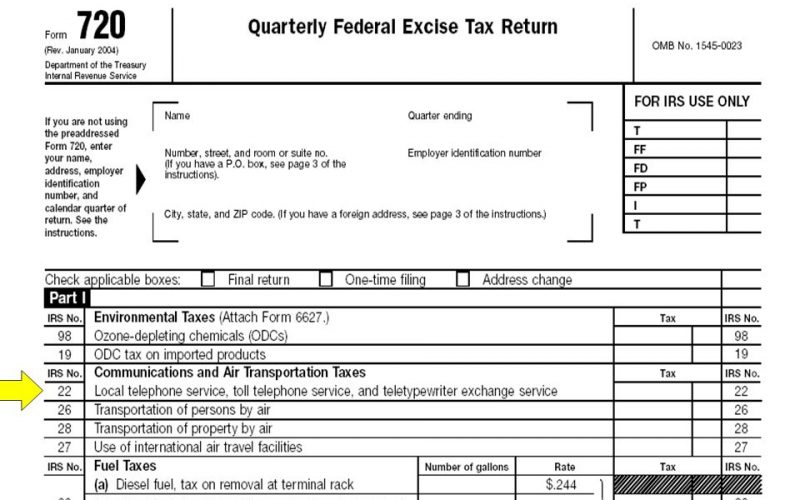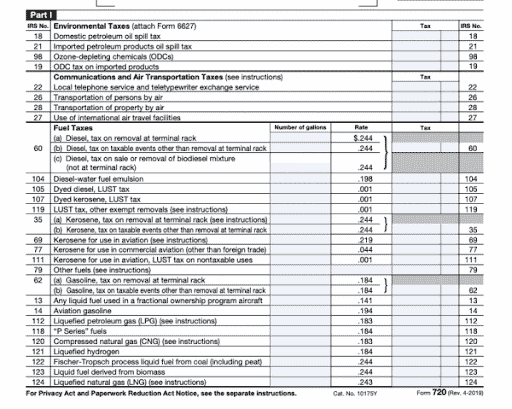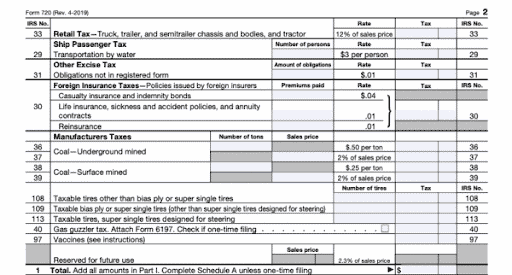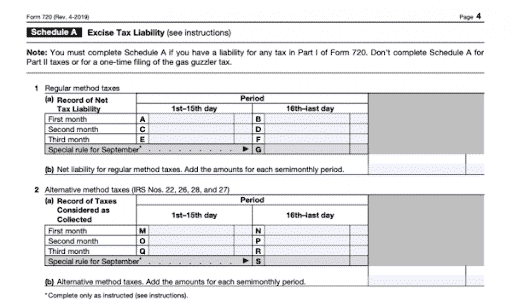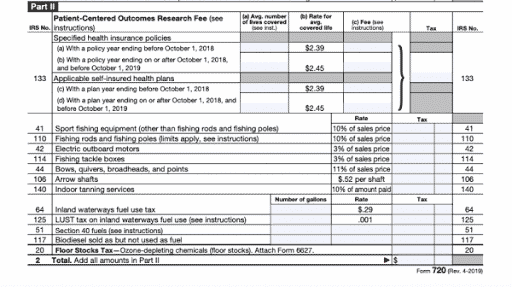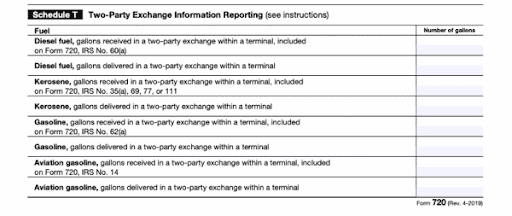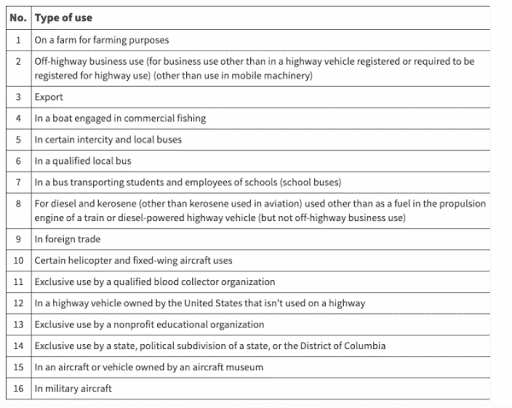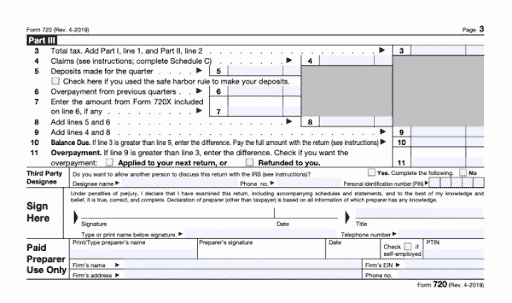If you own a business that sells goods and services subject to excise tax, you must file a Form 720 with the IRS quarterly.
The federal government levies an excise tax on some types of goods and services, which is similar to a state sales tax in some aspects. However, you may be unaware that you are paying this tax because it is frequently included in the price of commodities, such as gasoline for your automobile. Businesses that sell products and services that are subject to excise tax must file a Form 720 with the IRS quarterly. Let’s see the instructions on how to file Form 720 and the excise taxes.
What is a 720 Form?
IRS Form 720, Quarterly Federal Excise Tax Return, is a tax form used by businesses to report and pay federal excise taxes quarterly. If your company sells goods or services that are subject to excise tax, you must report and pay the taxes using IRS Form 720.
IRS Form 720 is divided into three sections, as well as sections for Schedule A, Schedule T, and Schedule C, as well as a payment voucher (called Form 720-V). If your company is required to file Form 720, you must do so quarterly and can do so electronically or by mail. Payments for excise taxes, on the other hand, are due semimonthly and must be done via electronic money transfer.
What is an Excise Tax?
An excise tax is a tax levied by the federal government on specified commodities or services manufactured in the United States or imported into the country. Excise taxes are frequently included in the cost of goods such as fuel or alcohol.
What should Form 720 Include?
The federal government collects excise taxes on a wide range of goods and services. A surcharge on indoor tanning, gasoline, airline tickets, and a variety of coal products are among the most common products and services subject to the excise tax. Because the excise tax is normally included in the price, it is the seller’s or manufacturer’s responsibility to remit these tax payments to the federal government and file Form.
Who Files Form 720?
If your company sells goods or services that are subject to excise taxes, you must file IRS Form 720. These items and services may include, but are not limited to, the following:
- Communication by telephone.
- Transportation by air.
- Gasoline.
- Transportation by passenger ship.
- Coal.
- Fishing tackle.
- Indoor tanning treatments are available.
- Arrows and bows
- Tires.
- Vaccines.
Form 720 outlines all of the goods and services that necessitate the payment of excise taxes by a firm. If your company does not sell any of the products or provide any of the services listed on the form, you are not subject to excise taxes and do not need to fill out this tax form.
Two more factors influence whether you must complete Form 720:
- You were due for, or in charge of, collecting any of the federal excise taxes specified on Parts I and II of Form 720 for a previous quarter and haven’t made a final return.
- For the current quarter, you were accountable for or responsible for collecting any of the federal excise taxes specified on Parts I and II of the form.
Although excise taxes are required for alcohol, tobacco, and guns, they are not covered by IRS Form 720. The Alcohol and Tobacco Tax and Trade Bureau regulates these products, and taxes must be filed using the return form available on their website.
Filling out Form 720
Form 720 has a line for each sort of excise tax that you may be required to pay. The vast majority of excise taxes are levied based on unit sales or weight.
For example, various types of diesel fuel demand around 24 cents per gallon. Simply enter the number of gallons sold and multiply it by the rate per gallon for this type of product.
Form 720, Quarterly Federal Excise Tax Return, is also available for electronic filing as an alternative. Simply choose an IRS-approved software provider and join millions of other taxpayers who benefit from the convenience and ease of online filing, prompt acknowledgment of receipt, and speedier service.
Paying your Excise Tax
If you owe excise tax when you file Form 720, the IRS requires you to pay by electronic funds transfer. To avoid fines, make sure your payment reaches the IRS before the deadline. This necessitates starting the transfer by 8 p.m. (EST) one day before the due date. The IRS requires you to make these deposits more regularly than you must file the form.
In general, most excise taxes must be paid semi-monthly. However, if the amount of excise tax is less than a specific threshold, the IRS will enable you to postpone payment until you have accumulated a substantial excise tax burden.
When to File Form 720
Businesses must file IRS Form 720 quarterly. The IRS Form 720 instructions break down the deadlines into a handy chart, which we’ve re-created here:
Quarter covered | Due by |
| First-quarter: January, February, March | April 30 |
| Second-quarter: April, May, June | July 31 |
| Third-quarter: July, August, September | Oct. 31 |
| Fourth-quarter: October, November, December | Jan. 31 |
If the due date for filing Form 720 comes on a Saturday, Sunday, or legal holiday, you have until the next working day to file.
Having your Excise Taxes Paid
Excise tax payments must be made semimonthly. The IRS defines a semimonthly period as the first 15 days of the month (first semimonthly period) or the 16th through the last day of the month (second semimonthly period) (second semi-monthly period).
- If your company pays excise taxes on communications or air transportation, you have the option of paying on a different timetable, as specified by the Form 720 instructions.
- Excise tax deposits must be sent to the IRS via electronic transfer (called an ACH deposit) and filed at least one day before the deposit’s due date; for example, if the deposit’s due date is January 15, the payment must be completed by January 14.
- If a due date falls on a weekend or legal holiday, the next business day becomes the de facto deadline, just as it does when filing Form 720.
Read Also: BACK OF CHECK: How to Sign, What to Write & Wrong Endorsement Solutions
Where can I find Form 720?
The IRS Form 720 and instructions are available on the IRS website.
- You can either print the form, fill it out, and mail it to the IRS. Also, you can fill it out on your computer, print it, and mail it to the IRS.
- You can also file electronically if you deal with an accountant or tax preparer who participates in the IRS e-file program for excise taxes.
- To find a provider in your area, search the IRS database of authorized providers.
Read Also: 1096 Form Instructions: Everything You Need To Know
Step-by-Step Guide on Form 720 Instructions
Now that you’ve covered the fundamentals, let’s delve into the individual components of form 720 and instructions on how to fill them out.
#1. Gather accounting records and fill your company’s details.
These reports, which can be generated by your accounting program, assist you in calculating excise taxes for Form 720. Your excise taxes are either a percentage of total sales or a percentage of units sold, depending on your specific firm.
The first section of the IRS form requests essential business information such as your name, address, quarter end date, and employer identification number, or EIN.
#2. Fill the applicable excise taxes and complete Form 720 Part I.
Fill out Part I of Form 720 if your company is required to pay the following taxes:
Petroleum oil spills, imported petroleum goods, and ozone-depleting chemicals are all subject to environmental taxes (if you must pay these environmental taxes, you must also submit IRS Form 6627).
- Taxes on communication and air travel: phone service or plane travel?
- Diesel, kerosene, gasoline, and natural gas all have fuel taxes.
- Trucks, trailers, and tractors are subject to retail taxes.
- Passenger tax on ships
- Health insurance policies issued by foreign insurers are subject to foreign insurance taxes.
- Manufacturers’ taxes include those on coal, tires, “gas guzzlers,” and vaccines.
Part I (as well as the IRS Form 720 instructions) specifies which products are eligible for completion of this part. If your company qualifies, enter the applicable rate in the “Rate” section to compute the taxes your company must pay.
Fill in the “Tax” column with your company’s tax burden based on total sales/units sold and the applicable rate. Add up all of the taxes and fill in the total at the bottom of Part I.
If none of the excise taxes in Part I apply to your company, skip ahead to Part II. However, if your company has a tax due under Part I, complete the Schedule A part of the IRS Form.
#2a. Fill out Form 720 after calculating your net tax liabilities. A Schedule
Schedule A of the IRS form is for firms with a tax due from any tax in Part I. If you do not have an obligation under Part I but do have liability under Part II, you do not need to fill Schedule A.
Schedule A shows your company’s net tax liability. Add the net tax liability for each tax for each semimonthly period in Schedule A and put the total in the applicable box.
Complete Schedule A, page 1 unless you are due for any of the alternative methods taxes, as indicated by the applicable IRS numbers (22, 26, 28, or 27 — Part I). If your company is liable for any of these taxes, fill out Schedule A, page 2.
#3. Calculate the relevant excise taxes and complete Form 720. Part Two
Fill out Part II of Form 720 if your company offers any of the following items or services:
- Specific health insurance policies.
- Sporting fishing gear.
- Outboard electric motors
- Arrows and bows
- Indoor tanning treatments are available.
- Fuel for waterways
Part II should be completed in the same manner as Part I. If your company qualifies for any of the goods or services listed in Part II, calculate your tax by utilizing the proper sales documents and the rate listed in the “Rate” column. Fill in the calculated tax in the “Tax” column and total it at the bottom of Part II.
The tax on health insurance is calculated differently from the other categories, using the average number of lives insured rather than units sold or total sales.
#4. Determine whether you need to fill out Schedule T or Schedule C and complete these sections of Form 720.
Determine whether you need to fill Schedule T or Schedule C of the IRS form before proceeding to Part III. Both Schedule T and Schedule C are related to fuel-related enterprises.
Schedule T
If your company manufactures or sells diesel fuel, kerosene, gasoline, or aviation gasoline, you just need to fill out Schedule T of the form. The total taxable fuel gallons received or given in a two-party trade within a terminal are reported on Schedule T.
The person receiving the gasoline, not the person giving it, is liable for the tax imposed on the transfer of taxable fuel from the terminal in a two-party trade. If your company trades with any of these fuel kinds as defined by the IRS as a two-party exchange, fill out Schedule T as shown below.
Schedule C
Schedule C, like Schedule T, applies to organizations that deal with one of the fuel kinds (as well as a few tire types) listed in Parts I and II of the IRS Form.
If you owe taxes under Part I or Part II, you may be able to decrease your liability by filing a claim on Schedule C. However, only certain fuels and use cases are eligible for a Schedule C claim. In the chart below, the IRS lists the user types that can qualify for a Schedule C claim:
If your gasoline business fits under one of the use-cases in this chart, you can fill Schedule C by identifying the use-case number, tax rate, number of gallons, and total dollar amount of your claim.
Once you’ve finished any relevant columns on Schedule C, total your final total on the last Schedule C page and enter it in line 15. Part III of the IRS Form should be completed using this total.
#5. Fill out Part III of Form 720
Part III of IRS Form 720 is where you determine your total taxes by adding the totals from Parts I and II and entering the total in box number 3.
If you completed Schedule C, enter the total amount of your claims in box number 4.
Fill in the blanks with your excise tax deposits for the quarter. If you overpaid in past quarters, enter the excess in boxes 6 and 7. Box 8 equals the sum of boxes 5 and 6, while box 9 equals the sum of boxes 4 and 8. If your total tax in box 3 is larger than your total tax in box 9, enter the difference in box 10 as your balance due. You must pay this amount with your Form 720 return filing.
If, on the other hand, box 9 is greater than box 3, you can specify what you want to do with the excess payment. You have the option of applying the money to your next return or having it refunded to you.
Finally, sign and date IRS Form 720. Indicate in the “third party designee” area if you intend to select a third person, such as your accountant, to discuss your return with the IRS. In addition, if your accountant or other tax professional created Form 720 for you, they fill out the “paid preparer use only” area.
#6. Submit Form 720 and pay any outstanding balances.
Fill out Form 720 before the deadline. There are two ways to file.
- Form 720 should be mailed directly to the IRS.
- If you’re completing the form through the IRS e-file program, file electronically.
When you file Form 720, you must also settle your outstanding balance (from box 10 of Part III).
- Your balance can be paid with a direct debit, cheque, or money order.
- If you file electronically, you must use a direct debit to pay.
- If you’re filing in person, fill out Form 720-V; this payment voucher form will go with your cheque or money order to pay your balance outstanding. When you file with the IRS, you will include Form 720-V with your completed Form 720.
Make copies of your completed form for your records before filing it.
Related: QDOT: Overview, Form, Sample, Requirements
IRS Form 720: Tips for Filling Out the Form
As you can see, completing IRS Form 720 entails several stages. Here are some pointers to keep in mind to assist speed up the process:
#1. Plan ahead of time.
Staying organized is one of the best ways to avoid errors and frustration when filling out tax papers like Form 720. Using your accounting platform and your bookkeeper or accountant, keep track of your inventory, sales, and other vital financial data. This way, when it comes time to fill out the form, you’ll have all of your information up to date, organized, and complete. In addition, remember the semimonthly excise tax payments and quarterly Form 720 filing dates. If you are unprepared, you are more likely to make errors on the form or to file late, which may result in late fees.
#2. Electronically submit your file.
By using the IRS’ e-file program, you may be able to save time, paper, stamps, and hassle. Furthermore, you will not be reliant on the mail system to achieve your deadline. Furthermore, completing Form 720 electronically allows you to examine information in your accounting software, refer to IRS filing instructions, and check for recent IRS revisions.
#3. Make use of a tax professional.
You will have access to someone with years of knowledge if you engage a tax advisor to complete, or assist you in completing, Form 720. Your tax professional will most likely be able to complete the form more quickly and accurately than you could if you did it yourself. Furthermore, if problems occur after you file the form, your tax advisor will be better prepared to resolve them and may be able to represent you before the IRS.
What happens if I don’t file Form 720 on time?
If you don’t file Form 720 on time, you may face penalties and fines from the IRS. It’s important to file the form by the due date to avoid any potential consequences.
Is there a fee for filing Form 720?
Yes, there is a fee associated with filing Form 720. The amount of the fee varies based on the type of excise tax being reported on the form.
Can I file Form 720 electronically?
Yes, Form 720 can be filed electronically through the IRS’s e-file system. Electronic filing is convenient and allows for faster processing times compared to paper filings.
What information do I need to complete Form 720?
To complete Form 720, you’ll need information such as your taxpayer identification number reported, the amount of the tax owed, and any relevant dates or transactions. Additionally, you may need to gather information about the specific type of excise tax you are reporting on the form, such as the type of goods or services being taxed and the method of calculation for the tax owed.
Can I file an amended Form 720?
Yes, if you need to make changes to your originally filed Form 720, you can file an amended form with the IRS. Be sure to include any necessary updates and submit the form as soon as possible to avoid potential penalties or fines.
How often do I need to file Form 720?
The frequency of filing Form 720 will vary based on the type of excise tax being reported. Some taxes may be reported on a quarterly basis, while others may be reported annually. It’s important to review the instructions for Form 720 to determine the required filing frequency for your specific situation.
Form 720 FAQs
Can I pay Form 720 online?
The IRS is now accepting electronically filed Forms 720. Forms can be submitted online 24 hours a day, seven days a week.
How do I file a 720?
Form 720 can be e-filed using the IRS website or your tax software. You can also pay an extra excise tax using the government’s Electronic Federal Tax Payment System (EFTPS).
How often do you file Form 720?
You must file a Quarterly Federal Excise Tax Return on Form 720 up to four times each year, depending on your circumstances, if you are a factory, store, airline, or any other firm that deals in commodities for which excise taxes are due.
Can you amend Form 720?
Form 720-X is used to make modifications to liabilities reported on Forms 720 for previous quarters. Except for the section 4051(d) tire credit and section 6426 credits, do not use Form 720-X to make adjustments to claims submitted on Form 720, Schedule C.
How do I file federal excise tax?
Federal excise taxes are collected quarterly and are due one month after the end of the quarter. To file, fill out Form 720 and mail it to the IRS by the due date, or file it online. The IRS accepts both paper and computerized Form 720 submissions.
How is excise tax calculated?
Divide the overall market income by the total number of excise products sold during the time to get the goods’ average tax base. To compute the hypothetical excise tax on the price, multiply the amount from step 4 by the applicable tax rate.
- 1096 Form Instructions: Everything You Need To Know
- IRS Attorney: Salary, Jobs, Fees, Best Options & All You Need
- How do Money Orders Work? (+How to Buy with Debit Cards)
- Tax Sheltered Annuity (TSA): 403 (b) Plans and Guidelines
- OASDI TAX: Old Age, Survivors, and Disability Insurance Contribution, Deferral & Payroll (Updated!)
- How to Fill Out a Money Order Correctly: Step by Step Guide
